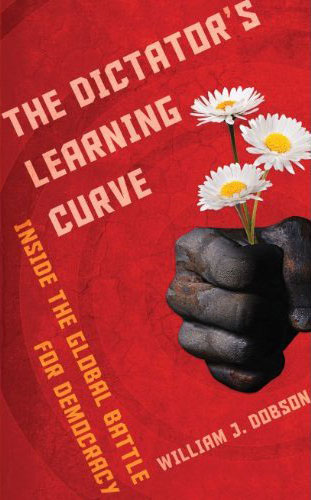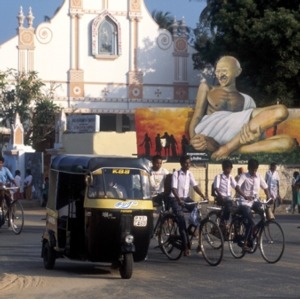 The Dictator’s Learning Curve: Inside the Global Battle for Democracy
The Dictator’s Learning Curve: Inside the Global Battle for Democracy
There is a fascinating, maybe a very important, book waiting to be written under something like this one’s title, and with something like the aim and focus suggested in the publisher’s blurb and advertising. It would also, naturally, be a very timely book, as we witness dictators falling or besieged from Syria and Egypt, Libya and Yemen, to China, Russia and Malaysia. Unfortunately, this ain’t it.
That book would explore – as this one’s title promises to do – how dictatorial regimes change to meet new challenges and to preserve their power. Among the obvious themes would be how military rulers pretend to become civilians, or hide their uniforms behind civvie-suited frontmen; how they adopt new technologies, new patterns of international alignment, even (as with the Gaddafi family) co-opt their critics’ languages of democratisation and human rights; how they learn to fake or steal elections; maybe above all how they cope with the hugely increasing difficulty in keeping their darker deeds secret in a world of email and iPhones, of Facebook, YouTube and Twitter. As Dobson stresses: “Today, the world’s dictators can surrender any hope of keeping their worst deeds secret … If you order a violent crackdown – even on a Himalayan mountain pass – you now know it will likely be captured on an iPhone and broadcast around the world.”
The book might take multiple forms. It could be something quite conceptually and theoretically ambitious, tracing the changing forms, the histories and ideologies of modern dictatorships and seeking to uncover any shared trajectories or common patterns in their rise, their crimes, their actual or possible fall. Or it might be rather dryly but illuminatingly quantitative, trying to answer questions like how many tyrannies there are in today’s world, where they are, whether their number is rising or declining, who runs them, who supports them, where they get their money, guns or tools of torture from. More vividly, we could have a work of reportage, necessarily based on wide travel and multiple interviews, with the author seeking out present or retired dictators, their servants, soldiers, publicists and more, attempting to find what makes them tick.
William Dobson’s track record would lead one to expect something most on the lines of that last. He’s politics and foreign affairs editor at Slate and a former editor at Foreign Affairs, Newsweek International and Foreign Policy, who’s also written for the New York Times, the Washington Post, and the Wall Street Journal. So, an experienced, high-flying journalist, wonderfully placed to learn, and to tell us, a great deal about how modern autocracy works.
He barely even tries. There is almost no analysis here of who or what contemporary dictators are and do, how they think or feel, how they seek to legitimise themselves, why they survive or die. There is not even much straight description of these things. Nor, for that matter, is there so much as a rough working definition or description of dictatorship – and as Dobson’s own assertions make plain, those are less than ever simple or obvious things.
Some of his main cases – notably Venezuela’s Hugo Chavez – are arguably pretty borderline, certainly with alarming authoritarian tendencies but also preserving most at least of the trappings of formal democracy and with a genuine popular base. Dobson’s treatment of his supposed main theme, how tyrants adapt to new times, does not actually go far beyond the terse comments of my summary above. He conducted, he tells us, over 200 interviews worldwide – but almost none of his subjects come from key positions inside the regimes concerned.
The vast majority of his interview subjects are in fact activists against dictatorship, and the great bulk of his text is not about the “learning curves” of tyrannies, but those of their opponents. As a description of global pro-democracy movements the book has some real strengths, well capturing the resourcefulness, skills and courage – though also the illusions, the failings and blind spots – of those remarkable people. One is left bemused as to why Dobson has saddled this vivid if superficial account of one thing with a title and publicity material promising quite another.
It’s not, though, as if changing the billing would solve all the problems. All the societies Dobson visits are riven with ethnic or religious divisions, which disturbingly often also mark off regime supporters from opponents. Dobson barely mentions any of that. Assad’s Alawite support base, or Chavez’s special appeal to those of indigenous rather than European descent, are key cases in point. And if divisions within these societies are one key theme that Dobson virtually overlooks, a yet more serious omission is the precise opposite: the power of appeals to unity.
Probably the strongest weapon wielded by authoritarian rulers in the modern world is, simply, nationalism. Urging people to unite behind the regime, asserting that opposition forces are agents of foreign powers or, simply, of an undefined but menacing “imperialism”, has been the main if not last recourse of rulers from Chavez to Mugabe, Milosevic to Omar al-Bashir.
In these pages you’ll meet lots of democracy activists, but not many dictators, nor much that helps explain them or their societies.

